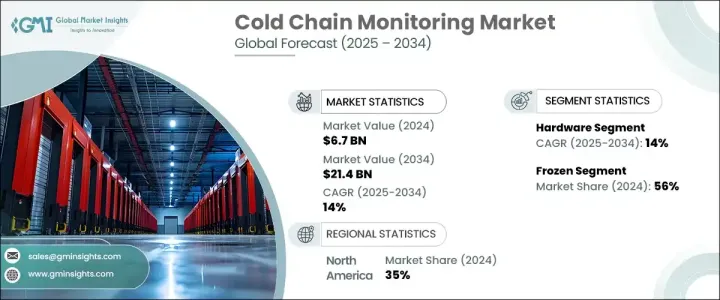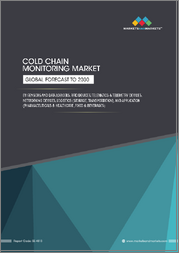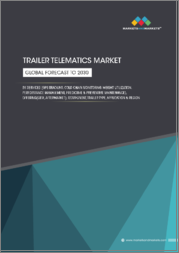
|
시장보고서
상품코드
1699313
콜드체인 모니터링 시장 기회, 성장 촉진요인, 산업 동향 분석, 예측(2025-2034년)Cold Chain Monitoring Market Opportunity, Growth Drivers, Industry Trend Analysis, and Forecast 2025-2034 |
||||||
세계의 콜드체인 모니터링 시장은 2024년 67억 달러에 이르렀고, 2025년부터 2034년까지 연평균 복합 성장률(CAGR) 14%를 나타낼 것으로 예측됩니다.
성장의 원동력이 되고 있는 것은 다양한 업계에서 온도 변화에 민감한 상품에 대한 수요가 높아지고 있는 것입니다. 규제 준수를 보장하기 위해 첨단 모니터링 솔루션을 채택하는 기업이 늘어나고 있습니다.

IoT 지원 센서, RFID 디바이스 및 텔레매틱스 솔루션의 통합은 업계에 변화를 가져오고 기업에게 물류 네트워크의 탁월한 가시성과 제어를 제공합니다. 기업은 리스크의 경감, 부패의 방지, 업무 효율의 강화에 주력하고 있어, 시장은 앞으로도 확대할 전망입니다.
| 시장 범위 | |
|---|---|
| 시작 연도 | 2024년 |
| 예측 연도 | 2025-2034년 |
| 시작 금액 | 67억 달러 |
| 예측 금액 | 214억 달러 |
| CAGR | 14% |
온도 관리 물류에 대한 의존도가 높아짐에 따라 시장 확대에 박차를 가하고 있으며, 기업은 제품의 안전성을 유지하고 진화하는 규제 기준을 준수하는 것이 중요하다는 것을 알고 있습니다. 스마트 모니터링 시스템의 채택은 공급망의 투명성을 향상시킬뿐만 아니라 제품 부패 및 리콜과 관련된 금전적 손실을 줄입니다.
시장 세분화에서 시장은 하드웨어와 소프트웨어 솔루션으로 구성되어 있습니다. 하드웨어 부문은 2024년에 45억 달러를 창출했으며 예측 기간 동안 연평균 14%의 성장률을 나타낼 것으로 예상됩니다. 온도에 민감한 물류에 대한 수요 증가는 센서, RFID 추적기 및 텔레매틱스 장치를 포함한 고급 하드웨어 솔루션의 채택을 촉진하고 있습니다. 콜드체인 업계의 진보에 따라 기업은 혁신적인 하드웨어 구성 요소를 활용하여 효율성과 신뢰성을 최적화하고 보관 및 운송 네트워크 전반에서 원활한 운영을 실현하고 있습니다.
온도대별로 보면, 시장은 냉동 부문와 칠드 부문으로 분류됩니다. 냉동 부문은 2024년에 시장 점유율의 56%를 차지했고, 2034년까지의 CAGR은 14%를 나타낼 것으로 예상되고 있습니다. 첨단 모니터링 기술은 온도에 민감한 제품의 효율성과 안정성을 유지하는 데 중요한 역할을 합니다.
북미는 2024년 세계의 콜드체인 모니터링 시장에서 35%의 점유율을 차지했으며, 미국이 21억 달러의 매출을 차지했습니다. 의약품 부문이 콜드 스토리지 솔루션에 대한 의존도를 높이고 있기 때문입니다. 또한 전자상거래 플랫폼을 통한 신선 식품 및 냉동 식품의 배송 수요 증가로 견고한 콜드체인 인프라의 필요성이 가속화되고 있습니다. 소비자의 기대와 규제상의 의무에 부응하고자 하는 가운데 혁신적인 모니터링 솔루션에 대한 투자가 급증하고 온도에 영향을 받기 쉬운 공급망의 신뢰성과 안전성이 강화될 것으로 예상됩니다.
목차
제1장 조사 방법과 조사 범위
- 조사 디자인
- 조사 접근
- 데이터 수집 방법
- 기본 추정과 계산
- 기준연도의 산출
- 시장추계의 주요 동향
- 예측 모델
- 1차 조사와 검증
- 시장 정의
제2장 주요 요약
제3장 업계 인사이트
- 생태계 분석
- 공급업체의 상황
- 하드웨어 제공업체
- 소프트웨어&플랫폼 개발 기업
- 시스템 통합자
- 연결성 제공업체
- 서비스 제공업체
- 이익률 분석
- 기술과 혁신의 전망
- 특허 분석
- 이용 사례
- 콜드체인 물류 통계
- 주요 뉴스와 대처
- 규제 상황
- 영향요인
- 성장 촉진요인
- 신선품에 대한 수요 증가
- 온도에 민감한 제품의 운송과 보관에 부과되는 엄격한 규제 요건
- 기술, IoT, 데이터 분석의 진보
- 식품의 안전성과 품질에 대한 관심 증가
- 업계의 잠재적 위험 및 과제
- 개발 도상 지역의 인프라 과제
- 높은 도입 비용과 복잡성
- 성장 촉진요인
- 성장 가능성 분석
- Porter's Five Forces 분석
- PESTEL 분석
제4장 경쟁 구도
- 서론
- 기업 점유율 분석
- 경쟁 포지셔닝 매트릭스
- 전략 전망 매트릭스
제5장 시장 추계·예측 : 구성 요소별(2021-2034년)
- 주요 동향
- 하드웨어
- 센서
- RFID 장비
- 텔레매틱스
- 네트워크 장비
- 기타
- 소프트웨어
- 실시간 모니터링
- 분석 및 보고
제6장 시장 추계·예측 : 온도별(2021-2034년)
- 주요 동향
- 냉동
- 냉장
제7장 시장 추계·예측 : 물류별(2021-2034년)
- 주요 동향
- 보관
- 운송
제8장 시장 추계·예측 : 최종 용도별(2021-2034년)
- 주요 동향
- 의약품 및 헬스케어
- 식음료
- 물류 및 유통
- 화학
- 기타
제9장 시장 추계·예측 : 지역별(2021-2034년)
- 주요 동향
- 북미
- 미국
- 캐나다
- 유럽
- 영국
- 독일
- 프랑스
- 이탈리아
- 스페인
- 러시아
- 북유럽
- 아시아태평양
- 중국
- 인도
- 일본
- 한국
- 뉴질랜드
- 동남아시아
- 라틴아메리카
- 브라질
- 멕시코
- 아르헨티나
- 중동 및 아프리카
- UAE
- 사우디아라비아
- 남아프리카
제10장 기업 프로파일
- Berlinger &Co
- CargoSense
- Cold Chain Technologies
- Controlant
- Descartes Systems Group
- Digi International
- ELPRO-BUCHS
- Emerson Electric
- Honeywell International
- Infratab
- Intelleflex
- Monnit
- ORBCOMM
- Roambee
- Sensaphone
- Sensitech
- Swisslog Holding
- Testo SE &Co
- Tive
- Zebra Technologies
The Global Cold Chain Monitoring Market reached USD 6.7 billion in 2024 and is anticipated to grow at a CAGR of 14% from 2025 to 2034. The growth is driven by the rising demand for temperature-sensitive goods across various industries. With pharmaceuticals, food, and beverage sectors relying heavily on cold storage and transportation, businesses are increasingly adopting advanced monitoring solutions to ensure product integrity and regulatory compliance. As companies continue to expand their global supply chains, the need for real-time tracking technologies is becoming more critical than ever.

The integration of IoT-enabled sensors, RFID devices, and telematics solutions is transforming the industry, offering businesses unparalleled visibility and control over their logistics networks. Regulatory authorities worldwide are imposing stringent guidelines to maintain optimal storage and transportation conditions, further propelling investments in cutting-edge monitoring systems. The market is poised for continued expansion as companies focus on mitigating risks, preventing spoilage, and enhancing operational efficiency. The adoption of AI-powered analytics and cloud-based monitoring platforms is reshaping the industry, enabling real-time decision-making and predictive maintenance to prevent temperature-related disruptions.
| Market Scope | |
|---|---|
| Start Year | 2024 |
| Forecast Year | 2025-2034 |
| Start Value | $6.7 Billion |
| Forecast Value | $21.4 Billion |
| CAGR | 14% |
The increasing reliance on temperature-controlled logistics is fueling market expansion, with businesses recognizing the importance of maintaining product safety and compliance with evolving regulatory standards. Companies are prioritizing the implementation of robust monitoring solutions to track environmental conditions in real time, ensuring that perishable goods remain within prescribed temperature thresholds. The adoption of smart monitoring systems is not only enhancing supply chain transparency but also reducing financial losses associated with product spoilage and recalls.
Segmented by components, the market consists of hardware and software solutions. The hardware segment generated USD 4.5 billion in 2024 and is set to grow at a CAGR of 14% throughout the forecast period. The increasing demand for temperature-sensitive logistics is driving the adoption of advanced hardware solutions, including sensors, RFID trackers, and telematics devices. These technologies provide real-time environmental data, enabling businesses to proactively address potential risks and maintain adherence to quality and safety standards. As the cold chain industry advances, companies are leveraging innovative hardware components to optimize efficiency and reliability, ensuring seamless operations across storage and transportation networks.
By temperature range, the market is categorized into frozen and chilled segments. The frozen segment accounted for 56% of the market share in 2024 and is expected to register a CAGR of 14% through 2034. The growing demand for ultra-low temperature storage solutions is accelerating adoption across industries that require strict thermal regulation, such as pharmaceuticals and biotechnology. Advanced monitoring technologies are playing a crucial role in preserving the efficacy and stability of temperature-sensitive products. As businesses strive to comply with rigorous storage requirements, they are investing in smart solutions that enhance traceability and minimize losses caused by temperature deviations.
North America led the global cold chain monitoring market with a 35% share in 2024, with the U.S. accounting for USD 2.1 billion in revenue. The region's strong market presence is attributed to the pharmaceutical sector's growing reliance on cold storage solutions to ensure product safety during transit. Strict regulatory guidelines in the U.S. emphasize the importance of maintaining temperature control, prompting companies to invest in advanced monitoring technologies. Additionally, the rising demand for fresh and frozen food deliveries through e-commerce platforms is accelerating the need for robust cold chain infrastructure. As businesses seek to meet evolving consumer expectations and regulatory mandates, investments in innovative monitoring solutions are expected to surge, reinforcing the reliability and security of temperature-sensitive supply chains.
Table of Contents
Chapter 1 Methodology & Scope
- 1.1 Research design
- 1.1.1 Research approach
- 1.1.2 Data collection methods
- 1.2 Base estimates and calculations
- 1.2.1 Base year calculation
- 1.2.2 Key trends for market estimates
- 1.3 Forecast model
- 1.4 Primary research & validation
- 1.4.1 Primary sources
- 1.4.2 Data mining sources
- 1.5 Market definitions
Chapter 2 Executive Summary
- 2.1 Industry 3600 synopsis, 2021 - 2034
Chapter 3 Industry Insights
- 3.1 Industry ecosystem analysis
- 3.2 Supplier landscape
- 3.2.1 Hardware providers
- 3.2.2 Software & platform developers
- 3.2.3 System integrators
- 3.2.4 Connectivity providers
- 3.2.5 Service providers
- 3.3 Profit margin analysis
- 3.4 Technology & innovation landscape
- 3.5 Patent analysis
- 3.6 Use cases
- 3.7 Cold chain logistics statistics
- 3.8 Key news & initiatives
- 3.9 Regulatory landscape
- 3.10 Impact forces
- 3.10.1 Growth drivers
- 3.10.1.1 Increasing demand for perishable goods
- 3.10.1.2 Stringent regulatory requirements imposed on the transportation and storage of temperature-sensitive products
- 3.10.1.3 Advancements in technology, IoT, and data analytics
- 3.10.1.4 Increasing focus on food safety and quality
- 3.10.2 Industry pitfalls & challenges
- 3.10.2.1 Infrastructure challenges in developing regions
- 3.10.2.2 High implementation costs and complexity
- 3.10.1 Growth drivers
- 3.11 Growth potential analysis
- 3.12 Porter's analysis
- 3.13 PESTEL analysis
Chapter 4 Competitive Landscape, 2024
- 4.1 Introduction
- 4.2 Company market share analysis
- 4.3 Competitive positioning matrix
- 4.4 Strategic outlook matrix
Chapter 5 Market Estimates & Forecast, By Component, 2021 - 2034 ($Bn)
- 5.1 Key trends
- 5.2 Hardware
- 5.2.1 Sensors
- 5.2.2 RFID devices
- 5.2.3 Telematics
- 5.2.4 Networking devices
- 5.2.5 Others
- 5.3 Software
- 5.3.1 Real-time monitoring
- 5.3.2 Analytics and reporting
Chapter 6 Market Estimates & Forecast, By Temperature, 2021 - 2034 ($Bn)
- 6.1 Key trends
- 6.2 Frozen
- 6.3 Chilled
Chapter 7 Market Estimates & Forecast, By Logistics, 2021 - 2034 ($Bn)
- 7.1 Key trends
- 7.2 Storage
- 7.3 Transportation
Chapter 8 Market Estimates & Forecast, By End Use, 2021 - 2034 ($Bn)
- 8.1 Key trends
- 8.2 Pharmaceutical & healthcare
- 8.3 Food & beverage
- 8.4 Logistics & distribution
- 8.5 Chemical
- 8.6 Others
Chapter 9 Market Estimates & Forecast, By Region, 2021 - 2034 ($Bn)
- 9.1 Key trends
- 9.2 North America
- 9.2.1 U.S.
- 9.2.2 Canada
- 9.3 Europe
- 9.3.1 UK
- 9.3.2 Germany
- 9.3.3 France
- 9.3.4 Italy
- 9.3.5 Spain
- 9.3.6 Russia
- 9.3.7 Nordics
- 9.4 Asia Pacific
- 9.4.1 China
- 9.4.2 India
- 9.4.3 Japan
- 9.4.4 South Korea
- 9.4.5 ANZ
- 9.4.6 Southeast Asia
- 9.5 Latin America
- 9.5.1 Brazil
- 9.5.2 Mexico
- 9.5.3 Argentina
- 9.6 MEA
- 9.6.1 UAE
- 9.6.2 Saudi Arabia
- 9.6.3 South Africa
Chapter 10 Company Profiles
- 10.1 Berlinger & Co
- 10.2 CargoSense
- 10.3 Cold Chain Technologies
- 10.4 Controlant
- 10.5 Descartes Systems Group
- 10.6 Digi International
- 10.7 ELPRO-BUCHS
- 10.8 Emerson Electric
- 10.9 Honeywell International
- 10.10 Infratab
- 10.11 Intelleflex
- 10.12 Monnit
- 10.13 ORBCOMM
- 10.14 Roambee
- 10.15 Sensaphone
- 10.16 Sensitech
- 10.17 Swisslog Holding
- 10.18 Testo SE & Co
- 10.19 Tive
- 10.20 Zebra Technologies



















